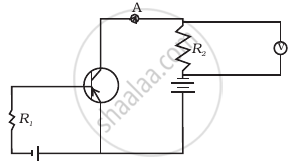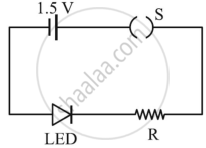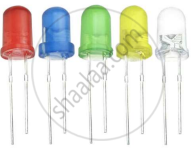Advertisements
Advertisements
Question
An ideal diode should pass a current freely in one direction and should stop it completely in the opposite direction. Which is closer to ideal-vacuum diode or a p-njunction diode?
Solution
It should be an ideal vacuum diode. When a pn junction diode is reverse biassed then a small current called reverse current flows across the diode.As the the p‒n junction diode allows some current in reverse biassed condition also so the given diode can not be a pn junction diode.
APPEARS IN
RELATED QUESTIONS
Meeta's father was driving her to school. At the traffic signal, she noticed that each traffic light was made of many tiny lights instead of a single bulb. When Meeta asked this question to her father, he explained the reason for this.
Answer the following questions based on above information:
(i) What were the values displayed by Meeta and her father?
(ii) What answer did Meeta's father give?
(iii) What are the tiny lights in traffic signals called and how do these operate?
If a small voltage is applied to a p-n junction diode, how will the barrier potential be affected when it is (i) forward biased
Using the necessary circuit diagrams, show how the V-I characteristics of a p-n junction are obtained in
Reverse biasing
How are these characteristics made use of in rectification?
How is a photodiode fabricated?
The current in the forward bias is known to be more (~mA) than the current in the reverse bias (~μA). What is the reason, then, to operate the photodiode in reverse bias?
Draw the circuit diagram of a full wave rectifier using p-n junction diode.
Explain its working and show the output, input waveforms.
What happens to the width of depletion player of a p-n junction when it is (i) forward biased, (ii) reverse biased?
Explain the formation of depletion layer and potential barrier in a p−n junction.
Draw the circuit arrangement for studying the V-I characteristics of a p-n junction diode in reverse bias. Plot the V-I characteristics in this case.
Write the important considerations which are to be taken into account while fabricating a p-n junction diode to be used as a Light Emitting Diode (LED). What should be the order of band gap of an LED, if it is required to emit light in the visible range? Draw a circuit diagram and explain its action.
Answer the following question.
Explain the three processes involved in solar cell working.
Explain photodiode.
What is the magnitude of the potential barrier across a Ge p-n junction?
For LED's to emit light in visible region of electromagnetic light, it should have energy band gap in the range of:
In Figure, assuming the diodes to be ideal ______.

If the resistance R1 is increased (Figure), how will the readings of the ammeter and voltmeter change?

Read the following paragraph and answer the questions.
|
LED is a heavily doped P-N junction which under forward bias emits spontaneous radiation. When it is forward-biased, due to recombination of holes and electrons at the junction, energy is released in the form of photons. In the case of Si and Ge diode, the energy released in recombination lies in the infrared region. LEDs that can emit red, yellow, orange, green and blue light are commercially available. The semiconductor used for fabrication of visible LEDs must at least have a band gap of 1.8 eV. The compound semiconductor Gallium Arsenide – Phosphide is used for making LEDs of different colours.
|
- Why are LEDs made of compound semiconductor and not of elemental semiconductors?
- What should be the order of bandgap of an LED, if it is required to emit light in the visible range?
- A student connects the blue coloured LED as shown in the figure. The LED did not glow when switch S is closed. Explain why?

OR
iii. Draw V-I characteristic of a p-n junction diode in
(i) forward bias and (ii) reverse bias
What energy conversion takes place in a solar cell?

